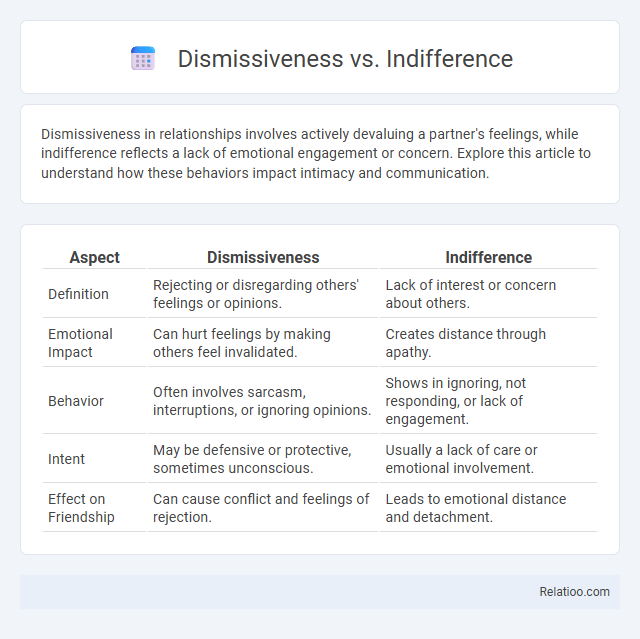Dismissiveness in relationships involves actively devaluing a partner's feelings, while indifference reflects a lack of emotional engagement or concern. Explore this article to understand how these behaviors impact intimacy and communication.
Table of Comparison
| Aspect | Dismissiveness | Indifference |
|---|---|---|
| Definition | Rejecting or disregarding others' feelings or opinions. | Lack of interest or concern about others. |
| Emotional Impact | Can hurt feelings by making others feel invalidated. | Creates distance through apathy. |
| Behavior | Often involves sarcasm, interruptions, or ignoring opinions. | Shows in ignoring, not responding, or lack of engagement. |
| Intent | May be defensive or protective, sometimes unconscious. | Usually a lack of care or emotional involvement. |
| Effect on Friendship | Can cause conflict and feelings of rejection. | Leads to emotional distance and detachment. |
Understanding Dismissiveness: Key Traits and Signs
Dismissiveness is characterized by a tendency to minimize or ignore others' feelings and opinions, often manifesting through rejecting or belittling responses. Key traits include lack of empathy, abrupt communication, and failure to acknowledge differing perspectives. Recognizing signs such as frequent interruptions, dismissive body language, and invalidation of concerns helps distinguish dismissiveness from indifference, which involves emotional detachment, or denial, which includes refusal to accept facts.
Indifference Defined: What Sets It Apart?
Indifference is characterized by a lack of interest, concern, or emotional investment in a situation or person, distinguishing it from dismissiveness, which involves rejecting or minimizing the importance of something, and from outright refusal or disregard implied by dismissiveness in other contexts. Your emotional detachment in indifferent attitudes signals neutrality rather than active negation, making it a unique emotional stance. Understanding these differences helps in accurately interpreting interactions and managing relationships effectively.
Dismissiveness vs Indifference: Core Differences
Dismissiveness involves actively rejecting or belittling someone's feelings or ideas, signaling a lack of respect or consideration, whereas indifference reflects a neutral or apathetic attitude without engaging emotionally. Dismissiveness often triggers conflict or hurt as it conveys invalidation, while indifference tends to create emotional distance through neglect or a lack of response. Understanding these core differences is crucial for addressing interpersonal communication barriers and improving relational dynamics.
Psychological Roots of Dismissive Behavior
Dismissive behavior often stems from deep-seated insecurities and defense mechanisms that protect individuals from emotional vulnerability or perceived threats. Indifference arises from emotional detachment or lack of empathy, sometimes linked to past experiences of neglect or trauma that inhibit emotional engagement. Understanding these psychological roots is essential for addressing the underlying causes and fostering healthier interpersonal dynamics.
Why People Become Indifferent: Main Causes
People become indifferent primarily due to emotional exhaustion, prolonged stress, or unresolved trauma that dulls their capacity to care. Indifference often arises when personal boundaries are overwhelmed, leading to detachment as a defense mechanism against further emotional pain. Understanding these causes helps you recognize patterns of disengagement and fosters healthier emotional resilience.
Effects of Dismissiveness in Relationships
Dismissiveness in relationships often leads to emotional withdrawal, decreased communication, and eroded trust, causing partners to feel unvalued and disconnected. Unlike indifference, which implies a lack of interest or concern, dismissiveness actively undermines a partner's feelings and perspectives, intensifying relational distress. The persistent effects include diminished intimacy, increased conflict, and a higher risk of relationship dissolution.
How Indifference Impacts Communication
Indifference in communication creates emotional distance, leading to misunderstandings and weakened relationships due to perceived lack of interest or empathy. Unlike dismissiveness, which overtly rejects or belittles ideas, indifference silently ignores messages, causing frustration and disengagement. Effective communication requires active listening and responsive engagement to overcome the barriers imposed by indifference.
Recognizing Dismissiveness in Yourself and Others
Recognizing dismissiveness in yourself and others involves noticing when opinions, feelings, or ideas are minimized or disregarded, often as a defense mechanism or lack of empathy. Unlike indifference, which reflects a lack of interest or concern, dismissiveness actively invalidates and undermines the significance of what is expressed, leading to communication breakdowns and eroded trust. You can cultivate awareness by observing patterns of reaction that shut down dialogue and by practicing openness to differing perspectives to foster stronger, more respectful connections.
Overcoming Indifference: Practical Strategies
Overcoming indifference requires intentional engagement and fostering empathy through active listening and meaningful interactions, which counteracts emotional detachment and apathy. Implementing goal-setting techniques and cultivating curiosity can stimulate motivation and interest, transforming disengagement into proactive involvement. Encouraging self-reflection and mindfulness helps individuals recognize underlying causes of indifference, promoting awareness and personal growth toward emotional investment.
Fostering Healthy Engagement: Moving Beyond Both
Fostering healthy engagement requires recognizing the subtle distinctions between dismissiveness, indifference, and passivity, as each fundamentally impacts communication dynamics and emotional connection. Dismissiveness actively invalidates others' feelings or ideas, while indifference reflects a lack of concern or interest, and passivity denotes avoidance of engagement altogether. Overcoming these barriers involves cultivating empathy, active listening, and open dialogue to create environments where individuals feel valued, respected, and encouraged to contribute meaningfully.

Infographic: Dismissiveness vs Indifference
 relatioo.com
relatioo.com